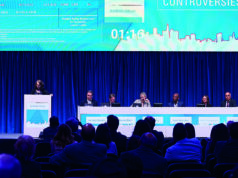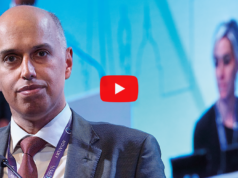
A post-market evaluation of the VenaSeal closure system (Medtronic) has found that, at one month, 100% of treated veins remained closed, quality of life scores improved significantly, and return to work and normal activity times were short. The data showed that treatment of multiple segments in one setting, large veins and superficial veins was safe, with further three-month follow-up now being analysed.
The WAVES trial is a US, single-centre, multiple provider study evaluating the VenaSeal system in the treatment of one or more incompetent truncal veins (greater saphenous vein, small saphenous vein or anterior accessory saphenous vein) with no compression stockings. The trial enrolled 50 patients with five providers, three of which previously participated in the VeClose trial. Follow-up was conducted at one week, one month and three months post-procedure, with the one-month data presented at EVF.
Kathleen Gibson, Lake Washington Vascular Surgeons, Bellevue, USA—who presented the data—explained that the WAVES trial differs from the VeClose trial, which compared cyanoacrylate embolisation and radiofrequency ablation for incompetent great saphenous veins. In the WAVES trial, veins up to 20mm were allowed, compared to 12mm for VeClose. Multiple segments could be treated in one session in the WAVES trial and the lengths of epifascial segments were tracked. Furthermore, pain scores were collected beyond the day of the procedure, CEAP clinical class 5 was allowed and no compression stockings were used.
The primary endpoint of the trial was the complete closure of the primary target vein—defined as a Doppler ultrasound examination showing closure along the entire treated segment with no discrete segments of patency exceeding 5cm. Secondary endpoints included pain intraoperatively and at each stage of follow-up, as well as return to work and return to full normal activity time.
In comparison to the VeClose trial, vein diameters were notably larger for WAVES. The mean largest greater saphenous vein diameter was 10±3.8mm, mean largest small saphenous vein 5.1±2.6mm and mean accessory saphenous vein 8.1±2.4mm. Gibson also noted that the mean venous clinical severity score (VCSS) was slightly higher than in previous trials at 6.5±2.4. Thirty-four per cent (17) of patients had CEAP clinical class C4a/b—more than the VeClose study (14%)—while 36% (18) were C2—less than the VeClose study (56%).
Gibson and colleagues treated 48 greater saphenous veins, 14 accessory saphenous veins and eight small saphenous veins—70 in total. Though this is “very early data,” Gibson said, at one month Duplex ultrasound showed that all treated veins remained closed. Mean procedure duration when treating one vein was 23±8 minutes. Duration increased as more veins were treated, to a mean of 34 minutes for two veins and 55 minutes for three veins (one case). Side branch or concomitant procedures were not included in the analysis. “In real-world practice we do allow that, but for a study like this they can confound the results,” Gibson explained.
Mean pain scores as measured by numerical rating scale 0–10 were 2 during access and 2.1 during the procedure. Post-procedure, mean pain scores were 1.6 at one week and 0.3 at one month. Thirty-four per cent of patients had a pain score of 0 at one week and 86% had a pain score of 0 at one month.
Quality of life was significantly improved at one month post-treatment. VCSS scores decreased from 6.5±2.4 at baseline to 1.8±1.4 at one month (p<0.001), while AVVQ scores fell from 17.3±7.9 at baseline to 8.9±6.6 (p<0.001).
Gibson and colleagues did not restrict return to work and normal activities, including exercise routines. The mean return to work was 0.2±1.1; most patients returning either on the same day of the procedure or the day after. Mean return to normal activities was 2.4±4.1 days. The researchers found that older patients (possibly due to more sedentary or part-time work) (p=0.028), those with shorter greater saphenous veins treated (p=0.022), and those with more advanced disease at baseline measured by CEAP (p=0.014) returned to work faster.
Adverse events included one vasovagal reaction, one case of hives treated with oral steroids, one case of gastroenteritis and one thrombus extension of 2mm, all of which were resolved within two weeks. Gibson told delegates, “We wanted to hone in on phlebitis, because this is very much looked at in the VeClose trial.” Phlebitis—the most common adverse event—was defined as any pain or tenderness more than the physician thinks to be normal for the procedure. Pain scores at seven days were higher in patients with phlebitis than without (4.2±1.9 vs. 1.3±1.5) (p<0.001), though this was driven by high pain scores in two patients with phlebitis. At one month, pain scores were 0.2±0.6 and 0.3±0.8 for patients with and without phlebitis, respectively (p<0.781). There was no difference in return to work for patients with and without phlebitis, at 0.1±0.3 vs. 0.3±1.2 days, respectively (p=0.634). There was also no significant difference in return to normal activity, at 3.5±3.7 vs. 2.1±4.2 days for patients with and without phlebitis, respectively (p=0.0331), although Gibson noted that this would most likely be different in a larger cohort.












